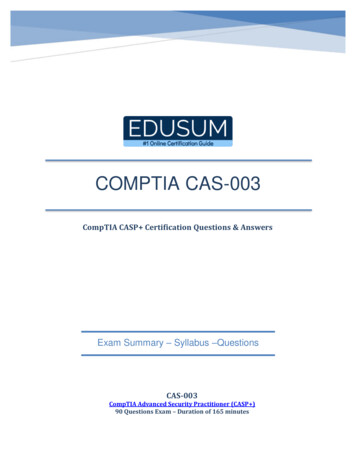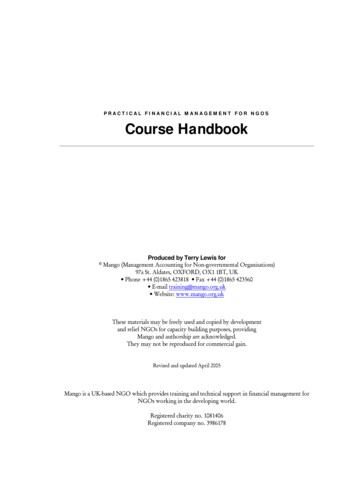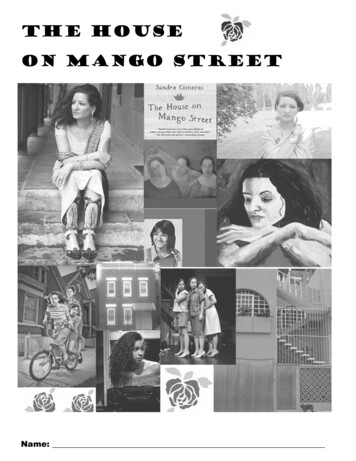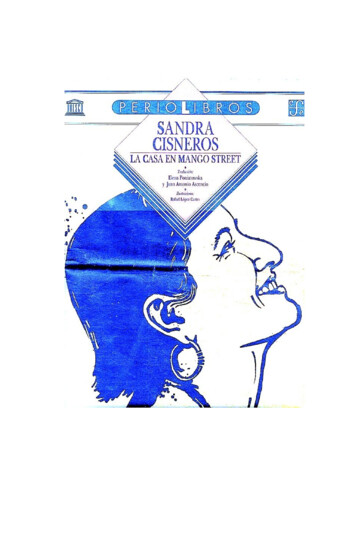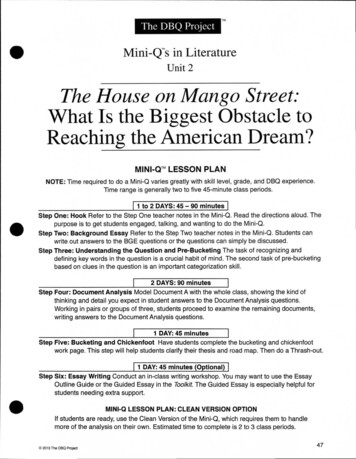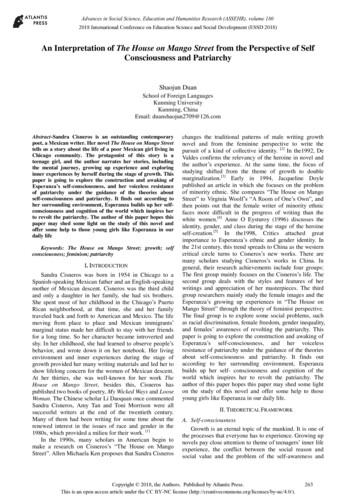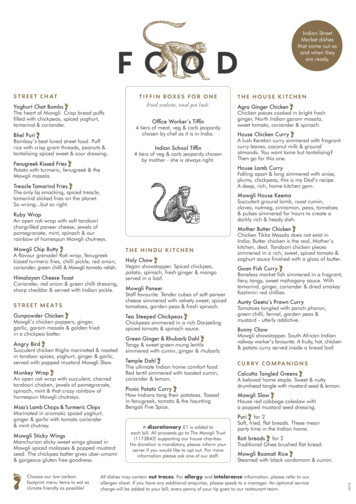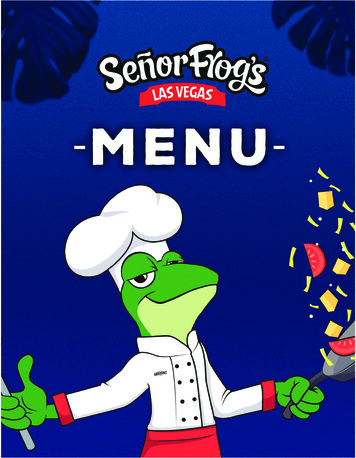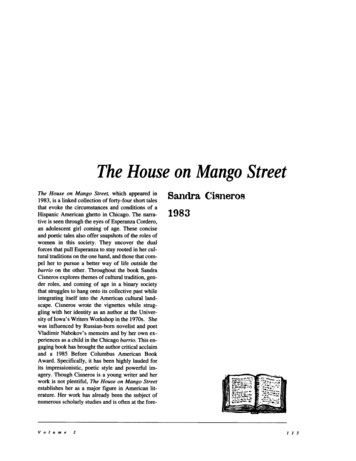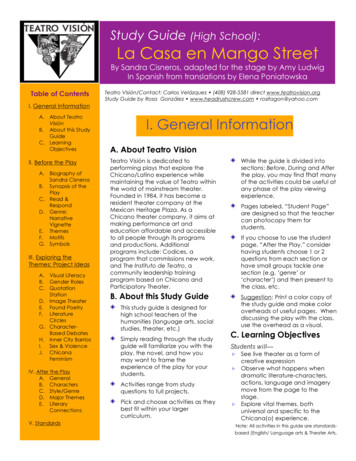
Transcription
Study Guide (High School):La Casa en Mango StreetBy Sandra Cisneros, adapted for the stage by Amy LudwigIn Spanish from translations by Elena PoniatowskaTable of ContentsTeatro Visión/Contact: Carlos Velázquez (408) 928-5581 direct www.teatrovision.orgStudy Guide by Rosa González www.headrushcrew.com rositagon@yahoo.comI. General InformationA.About TeatroVisiónB. About this StudyGuideC. LearningObjectivesII. Before the PlayA.Biography ofSandra CisnerosB. Synopsis of thePlayC. Read &RespondD. Genre:NarrativeVignetteE. ThemesF. MotifsG. SymbolsIII. Exploring theThemes: Project IdeasA. Visual LiteracyB. Gender RolesC. QuotationStationD. Image TheaterE. Found PoetryF. LiteratureCirclesG. CharacterBased DebatesH. Inner City BarriosI.Sex & ViolenceJ. ChicanaFeminismIV. After the PlayA. GeneralB. CharactersC. Style/GenreD. Major ThemesE. LiteraryConnectionsV. StandardsI. General InformationA. About Teatro VisiónTeatro Visión is dedicated toperforming plays that explore theChicano/Latino experience whilemaintaining the value of Teatro withinthe world of mainstream theater.Founded in 1984, it has become aresident theater company at theMexican Heritage Plaza. As aChicano theater company, it aims atmaking performance art andeducation affordable and accessibleto all people through its programsand productions. Additionalprograms include: Codices, aprogram that commissions new work,and The Instituto de Teatro, acommunity leadership trainingprogram based on Chicano andParticipatory Theater.While the guide is divided intosections: Before, During and Afterthe play, you may find that manyof the activities could be useful atany phase of the play viewingexperience.B. About this Study GuideSuggestion: Print a color copy ofthe study guide and make coloroverheads of useful pages. Whendiscussing the play with the class,use the overhead as a visual.This study guide is designed forhigh school teachers of thehumanities (language arts, socialstudies, theater, etc.)Pages labeled, “Student Page”are designed so that the teachercan photocopy them forstudents.If you choose to use the studentpage, “After the Play,” considerhaving students choose 1 or 2questions from each section orhave small groups tackle onesection (e.g. ‘genre’ or‘character’) and then present tothe class, etc.Section 1.02 Second Story HeadlineSimply reading through the studyguide will familiarize you with theplay, the novel, and how youmay want to frame theexperience of the play for yourstudents.Activities range from studyquestions to full projects.Pick and choose activities as theybest fit within your largercurriculum.C. Learning ObjectivesStudents will—See live theater as a form ofcreative expressionObserve what happens whendramatic literature-characters,actions, language and imagerymove from the page to thestage.Explore vital themes, bothuniversal and specific to theChicana(o) experience.Note: All activities in this guide are standardsbased (English/ Language arts & Theater Arts.
Page 2 of 8Study Guide: La Casa en Mango Street Student PageII. Before the PlayA. Biography of Sandra CisnerosSandra Cisneros,Author of TheHouse on MangoStreetSandra Cisneros (born December 20, 1954 in Chicago) is a Latinaauthor and poet best known for her novel The House on Mango Street.She is also the author of Caramelo, (2002), Woman Hollering Creekand Other Stories (1991), My Wicked Wicked Ways (1987) and acollection of poems, Loose Woman. Her books and poetry have beentranslated into over a dozen languages.Sandra was the only daughter in her family of seven. HerMexican father, Mexican-American mother, and her family movedthrough a series of run-down apartments in the poor neighborhoods ofChicago's South Side. While a teenager, her family realized her dreamof purchasing a house, although she considered it old and ugly. Thisprobably inspired much of The House on Mango Street. Her writing isinfluenced by many aspects of her life, including her childhood, herfamily, and her Mexican heritage.She has taught as a visiting professor at Britain State University,California State University- Chico, University of California, Berkeley andIrvine, University of Michigan, Ann Arbor, and at the University of NewMexico, Albuquerque. The House on Mango Street was awarded theAmerican Book Award by the Before Columbus Foundation, in 1985,among other awards, and in 1995 Cisneros was named a MacArthurFellow.B. Synopsis of the Play“I always tellpeople that Ibecame a writernot because I wentto school butbecause mymother took me tothe library.I wanted tobecome a writer soI could see myname in the cardcatalog.”-Sandra CisnerosThe House on Mango Street (HMS)covers a year in the life of Esperanza,a twelve-year-old girl who moveswith her family into a house onMango Street in the center of acrowded Latino neighborhood inChicago.Narrated by an older Esperanza, theplay charts her life as she maturesduring the year, both physically andemotionally. The play also includesthe stories of many of Esperanza’sneighbors, giving a full picture of theneighborhood and showing themany influences surrounding her.Esperanza quickly befriends Lucy andRachel, who along with Esperanza'slittle sister Nenny, have manyadventures in the small space of theirneighborhood. Esperanza begins towrite as a way of expressing herselfand to escape the suffocating effectof the neighborhood. She laterrealizes that she will never fully beable to leave Mango Street behind,and vows that after she leaves shewill return to help the people she hasleft behind.C. Read and RespondRead the synopsis of the play and thebiography of Sandra Cisneros andanswer the following questions:1. In what ways is House on MangoStreet inspired by Cisneros’ own life?2. What is the significance of a hometo families? --To your family? --ToSandra Cisneros’ family?”3. If you could ask Sandra Cisnerosthree questions, what would you askher?Optional: Through internet researchand further reading, find answers tothese questions.
D. Genre: Narrative VignetteThe novel bySandra Cisneros.The House on Mango Street is acollection of vignettes that are notquite poems and not quite fullstories. Esperanza narrates thesevignettes in first-person presenttense, focusing on her day-to-dayactivities but sometimes narratingsections that are just a series ofobservations. The vignettes can beas short as two or three paragraphs long and sometimes contain internalrhymes.Choose one or more vignettes fromthe novel maPapa1. Identify some of the poeticdevises Cisneros’ uses in herwriting (e.g. imagery, rhyme,metaphor, personification,repetition).2. How does the style of the writing(i.e. short vignettes, manycharacters, unresolved conflicts,etc.) help to capture the realityof a young girl growing up in aninner city?3. Characterization: How doesCisneros help the reader to knowher characters? Choose acharacter and find examples ofhow Cisneros brings thatcharacter to life through whatthe character says, what otherssay about him/her, what thecharacter does, and how s/hechanges over time.4. Explore the genre:Write your own series of shortnarratives about yourexperiences growing up. Usefigurative language and creativewriting structure to help thereader see and feel your shortstories.E. ThemesThemes are the fundamental and oftenuniversal ideas explored in a literary work.The Power of languageThe Struggle for PersonalIdentity & SpaceSexuality vs. IndependenceGrowing upGender rolesHome/NeighborhoodDeathShame1. How do these themes playout in The House on MangoStreet?2. What connections can youdraw between one of thesethemes in HMS and the sametheme in another piece ofliterature, a movie, or yourown life?F. MotifsMotifs are recurring structures, contrasts, orliterary devices that can help to developand inform the text's major themes.The Power of NamesFallingWomen by Windows1. Based on the play or on thenovel, what do you thinkCisneros is communicatingwith each of these motifs inHMS?G. SymbolsSymbols are objects, characters, figures, orcolors used to represent abstract ideas orconcepts.ShoesTreesPoetry1. What do each of thesesymbols represent in TheHouse on Mango Street?2. What do these symbolsmean to you?Page 3 of 8Study Guide: La Casa en Mango Street Student Page
Page 4 of 8Study Guide: La Casa en Mango Street Teacher PageIII. Project Ideas: Exploring the Themes, Motifs & SymbolsNote: These projects could occur anytime during the House on Mango Street experience as theyserve both to build background knowledge for the play and to reflect on the play.Visual Literacy: This is a creativeBarrio by OscarOrtiz.“No, this isn't myhouse I say andshake my headas if shakingcould undo theyear I've livedhere. I don'tbelong. I don'tever want tocome fromhere.”Dos Mujeres en laVentana by RufinoTamayo.way to engage your studentsaround the themes of The HMS:Make color overheadtransparencies of fine art pieces(paintings, murals, etc.) thatembody given themes from HMS.For each painting, promptstudents to share aloud or writedown (or both):o What do you see inthis painting?o What ideas or feelingsdoes this pieceexpress?o What story does thispainting tell?o What connections canyou make betweenthis piece and TheHouse on MangoStreet? What themefrom HMS does thispainting convey?The point is to spark interest in themain ideas of the play and getstudents thinking symbolicallyabout the feelings and storiesthat images portray.Gender Roles: Conduct ananthropological report on genderroles in your family. The wordgender refers to our identities aseither male or female. In HMS,boys and girls have very differentlives, expectations, and problems.The young characters seem to belearning gender role expectationsfrom the generation before them,but at the same time, Esperanzais forging a new path for herself. ,How were boys and girlsexperiences similar or differentwhen your parents were children?–How about when yourgrandparents were growing up?o Questions- Brainstorm1-5 questions that willhelp youunderstand howgender roles in yourfamily havechanged over time,if at all.Interviews- Interview your parentsand/or a male and female familymember from your parentsgeneration/age, then interviewQuotation Station: Chooseseveral quotations from theplay that capture variousthemes from HMS (There areseveral in the margins of thisstudy guide.) and havestudents interact with them inone or more of the followingways:o Analyze what thedeeper meaningsare within thequotation;o Make a predicationabout the storybased on thequotation;o Use the quotationas a story starterand continue thestory;o Brainstormeverything thequotation makesyou think of.o“In English myname meanshope. In Spanish itmeans too manyletters. It meanssadness, it meanswaiting.”
Image Theatre: Choose atheme from The House onMango Street and brainstormwith the class a list of words,ideas, emotions, memories,headlines, etc. that theyassociate with that concept.Use these words as prompts forindividual and group tableaus.Invite the group to reflect onwhat they see in the tableausand record these reflections,offering them to the group asinspiration and content forindividual or group poems,scenes, short stories, essays,etc.Found Poetry: Choose atheme or a feeling and writedown or cut out words andphrases (from the play ornovel) related to that theme orfeeling. Rearrange the wordsto create a poem of your own.Literature Circles: In smallgroups, agree to read aspecific set of pages and thenmeet to discuss the section.Have everyone come up withtwo clarification questions andtwo discussion questions to askat the literature circle. Duringeach meeting, identify whatthemes, symbols and motifswere present in the assignedreading. Discuss theirsignificance.Character-based debates:This is a fun way to combinetheatre with social studiestopics. Choose a theme fromthe play and assign eachstudent a character from theplay who is ideologicallyconnected to that theme.Students analyze thatcharacter’s perspective inpreparation for a debate orpanel discussion on the topic.Some students can playcharacters while others playmoderators or reporters whoask the questions.Additional Topics to Explorethrough research, writing, and/ordiscussion:Inner City Barrios: The wordbarrio is Spanish for neighborhoodand often refers to a workingclass neighborhood similar to aghetto. Research the inner city ofChicago. How has the ethnicdiversity changed over time?What conflicts have emergedover housing and gentrification ofChicago’s barrios? What is thesignificance of home ownershipamong working class families?Sex and Violence: ThroughEsperanza’s experiences in TheHouse on Mango Street, thereader/viewer is introduced tothe harsh reality of sex and sadlyviolence. What other works ofliterature expose issues ofviolence against women? Whatmessages do young people thesedays receive about sex andviolence through music, televisionand movies?Chicana Feminism: In themainstream, people tend to befamiliar with a brand of feminismput forth mostly by white women.Women of color, however, haveasserted alternative ideas aboutwomen’s liberation. ResearchChicana feminism, drawing uponbooks such as, Feminism on theBorder: Chicana Gender Politicsand Literature. By Sonia SaldívarHull and The Bridge called myBack: Writings by Radical Womenof Color by Gloria Anzaldúa.What do Chicana feminists sayabout women’s liberation? Howdoes Sandra Cisneros useliterature to assert her own ideasabout growing up female in amale dominated world?Falling Womanby Picasso“The House onMango Street isours, and we don’thave to pay rentanybody, or sharethe yard with thepeople downstairs,or be careful notto make too muchnoise, and there isa landlordbanging on theceiling with abroom.”Self-portrait as laVirgen deGuadalupeYolanda LópezPage 5 of 8Study Guide: La Casa en Mango Street Teacher Page
Page 6 of 8Study Guide: La Casa en Mango Street Student PageIV. After the PlayA. General- After seeing the play, The Houseon Mango Street, reflect:1. What stands out in your mind as you thinkabout the play?2. Do you believe the playwright intended usto walk away with a particular message oridea? If so, what do you think are themain messages?3. How does this play impact its audience?What are we left with at the end of theplay?4. What questions does this play spark foryou?5. In-depth: Write a review of the play,focusing on acting, style, genre, design,and theme.B. Characters- Reflect on how thecharacters change over the course of theplay:1. Name three ways Esperanza changesover the course of the play and includedetails about the events that cause her tochange.2. What role does writing play in Esperanza’slife?3. Discuss the role of parents in the novel.How can Esperanza's relationship with herparents be characterized? In what ways isit different or similar to other characters'parent/child relationships in the novel?4. In-depth: Write an essay and/or create achart analyzing Esperanza as a character.Use the main themes from The House onMango Street to create your outline, anddescribe the various aspects ofEsperanza’s life.C. Style/Genre- The House on Mango Streetas presented by Teatro Visión is a Chicanoplay based on a narrative vignette novel.These questions relate to this specific genre:1. One writing strategy that the playwright,Amy Ludwig, employed when shetransformed the novel into a play, was todivide the narrator voice between ayoung Esperanza and an older Esperanza.SandraCisnerosWhat effect does this techniquehave on the story?2. Much of the narrative from thenovel is divided up between variouscharacters in the play, breaking upsentences and paragraphs tocreate a dynamic rhythm. Write ananalysis of this technique in theproduction. How effective was theuse of language and rhythm? Whateffect did it have on the story andon the performance?3. What role does music play in theproduction? What effect did thesongs used in the play create?4. What is significant about seeing thelives of a Chicano (MexicanAmerican) family in Chicagoplayed out on stage in San José,CA?5. Why do you think Cisneros and theplaywright choose not to try torepresent dialect, slang, oraccents?6. In-depth: Take one of the narrativevignettes you have written and turnit into a short scene. Try dividing upthe narrative among variouscharacters in the story to create adynamic rhythm with the lines.Choose a few classmates to readyour piece aloud. Get feedbackfrom the class and make anynecessary adjustments.
D. Major Themes- Reflect on thebig ideas that unfold in The House onMango Street:1. What role does death play in TheHouse on Mango Street? How dothe many deaths in the novelrelate to one another, and howdo they influence Esperanza?2. What role does magic or thesupernatural play in The Houseon Mango Street? How does itaffect and influence Esperanza?3. In what ways does writing setEsperanza apart from herneighborhood? In what waysdoes it help her integrate into herneighborhood?4. How do race and gender comeinto conflict in The House onMango Street? Does one triumphas the more important concern,or do both issues receive equalconsideration?5.What does the house on MangoStreet represent to Esperanzaand to her family? What is thesignificance of home? Whatdoes Esperanza seem to learnabout “home” over the course ofthe play?“They thinkwe aredangerous.6. The House on Mango Streetis a ‘coming of age’ story,meaning that it is aboutgrowing up, leavingchildhood behind. Whatevents in the play contributeto Esperanza’s ‘coming ofage?’They think wewill attackthem withshiny knives.“7. As Esperanza is growing up,she is more and more awareof issues regardingeconomic class and ethnicprejudice. How is thisillustrated in the play?8. How are sex and violencelinked in The House onMango Street? Why doesEsperanza both seek and tryto avoid sexual experiences?9. How does Esperanza asserther own identity?E. Connections- Identify literary connections between The House on Mango Street andother works:1. Women of Color: Young Cornrows Callin' Out the Moon by Ruth Forman- Compare andcontrast Foreman’s and Cisneros’ writings about childhood. Focus on content and onstyle. How does each writer’s environment affect her writing?2. Chicana Literature: Quintana, Alvina E., Home Girls: Chicana Literary Voices. Philadelphia:Temple University Press, 1996. Write an essay analyzing The House on Mango Street basedon the main points put forth in this book about Chicana Literature.3. Coming of Age: James Joyce's A Portrait of the Artist as a Young Man. Like the hero of thatnovel, Stephen Dedalus, Esperanza has a keen eye for observation and is gifted in her useof language. Write a compare and contrast essay on these two works of literature. Whatdo the similarities revieal about humanity in general? What do the differences revealabout how one’s environment influences one’s ideas of self?4. A Place of Her Own: Virginia Woolf's A Room of One's Own, a long essay in which Woolfasserts that women need a place and financial resources of their own in order to writesuccessfully. In what ways are Woolf and Cisneros making similar assertions? How are thetwo author’s strikingly different backgrounds made evident in the differences betweenthese two pieces of writing?Page 7 of 8Study Guide: La Casa en Mango Street Student Page
Teatro VisiónV. StandardsTheater/Performing Arts, 9th – 12th gradesAddress:Mexican Heritage Plaza1700 Alum RockAvenue, Suite 265San José, CA org.We’re on theWeb:www.teatrovision.org1.0ARTISTIC PERCEPTIONProcessing, Analyzing, and Responding to Sensory InformationThrough the Language and Skills Unique to TheaterStudents observe their environment and respond, using the elements of theater. They alsoobserve formal and informal works of theater, film/video, and electronic media andrespond, using the vocabulary of theater.Development of the Vocabulary of Theater1.1 Use the vocabulary of theater, such as acting values, style, genre, design, and theme,to describe theatrical experiences.Comprehension and Analysis of the Elements of Theater1.2 Document observations and perceptions of production elements, noting mood,pacing, and use of space through class discussion and reflective writing.2.0 CREATIVE EXPRESSIONCreating, Performing, and Participating in TheaterStudents apply processes and skills in acting, directing, designing, andscriptwriting to create formal and informal theater, film/videos, and electronicmedia productions and to perform in them.Development of Theatrical Skills2.1 Make acting choices, using script analysis, character research, reflection, and revisionthrough the rehearsal process.Celebrating culture.Nurturing community.Inspiring vision.Creation/Invention in Theater2.2 Write dialogues and scenes, applying basic dramatic structure: exposition,complication, conflict, crises, climax, and resolution.2.3 Design, produce, or perform scenes or plays from a variety of theatrical periods andstyles, including Shakespearean and contemporary realism.3.0 HISTORICAL AND CULTURAL CONTEXTUnderstanding the Historical Contributions and CulturalDimensions of TheaterStudents analyze the role and development of theater, film/video, and electronic media inpast and present cultures throughout the world, noting diversity as it relates to theater.Role and Cultural Significance of Theater3.1 Identify and compare how film, theater, television, and electronic media productionsinfluence values and behaviors.3.2 Describe the ways in which playwrights reflect and influence their culture in such worksas Raisin in the Sun, Antigone, and the Mahabarata.4.0 AESTHETIC VALUINGResponding to, Analyzing, and Critiquing Theatrical ExperiencesStudents critique and derive meaning from works of theater, film/video, electronic media,and theatrical artists on the basis of aesthetic qualities.Critical Assessment of Theater4.1 Compare a traditional interpretation of a play with a nontraditional interpretation anddefend the merits of the different interpretations.Derivation of Meaning from Works of Theater4.2 Report on how a specific actor used drama to convey meaning in his or herperformances.
translated into over a dozen languages. A. Biography of Sandra Cisneros Sandra Cisneros (born December 20, 1954 in Chicago) is a Latina author and poet best known for her novel The House on Mango Street. She is also the author of Caramelo, (2002), Woman Hollering Creek and Other Stories (1991), My Wicked W


